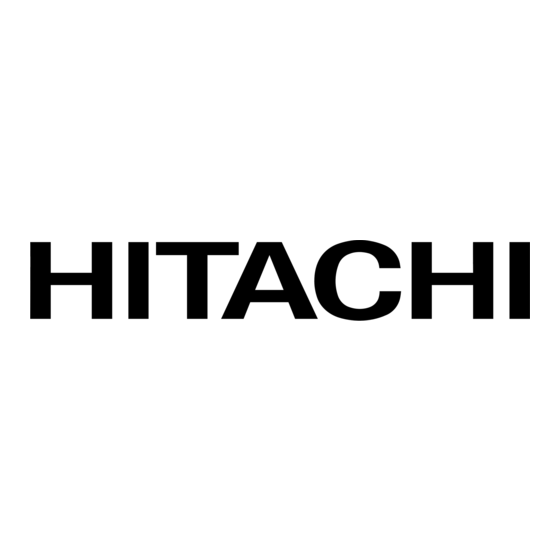

Hitachi UC 9SD Technical Data And Service Manual
Charger
Hide thumbs
Also See for UC 9SD:
- Instruction manual and safety instructions (28 pages) ,
- Instruction manual and safety instructions (28 pages) ,
- Handling instructions manual (30 pages)
Summary of Contents for Hitachi UC 9SD
- Page 1 MODEL UC 9SD POWER TOOLS TECHNICAL DATA CHARGER UC 9SD SERVICE MANUAL LIST No. F836 Nov. 1999 SPECIFICATIONS AND PARTS ARE SUBJECT TO CHANGE FOR IMPROVEMENT...
-
Page 2: Table Of Contents
Notice for use Specifications and parts are subject to change for improvement. Refer to Hitachi Power Tool Technical News for further information. CONTENTS Page [ Business Section ] 1. PRODUCT NAME • • • • • • • • • • • • • • • • • • • • • • • • • • • • • • • • • • • • • • • • • • • • • • • • • • • • • • • • • • • • • • • • • • • • • • • • • • • • • • • • • • • • • • • • • • • • • • • • • • • • • • • • • • • • • • • • • • • • • • • •... -
Page 3: Product Name
2. MARKETING OBJECTIVE The Model UC 9SD is an inexpensive 9.6 V-only charger that has been developed to promote sales of our low- cost cordless tools. It is designed to charge the Hitachi types EB 9S, FEB 9 and FEB 9S rechargeable batteries. -
Page 4: Specifications
Operating temperature 10 ˚C --- 40 ˚C (50 ˚F --- 104 ˚F) 5-2. Comparisons with Similar Product HITACHI HITACHI Model Unit UC 9SD UC 12SD Charging time min. 60 (FEB 9S storage batteries) 60 (FEB 12S storage batteries) Charging voltage Charging current 1.55... -
Page 5: Precautions In Sales Promotion
6-1. Safety Instructions In the interest of promoting the safest and most efficient use of the Model UC 9SD Charger by all of our customers, it is very important that at the time of sale the salesperson carefully ensures that the buyer seriously recognizes the importance of the contents of the Handling Instructions, and fully understands the precautions listed on the Caution Plate and Nameplate attached to the Charger. -
Page 6: Points Requiring Special Attention During Sales Promotion
This condition is common to all existing chargers (both Hitachi's and competitor's models) which employ temperature sensitive devices to terminate charging. The cooling period required before charging varies from a few minutes to about 30 minutes, depending on the length of time the battery was used and the ambient temperature. -
Page 7: Reference Material
7. REFERENCE MATERIAL 7-1. Model UC 9SD Structure (1) The outer casing consists of Case (A) and Case (B). A light bar for the Pilot Lamp is built into Case (A). (2) Electronic components which provide rapid charging and prevent overcharging are mounted on the Printed Circuit Board. -
Page 8: Reassembly
Lead Wire Printed Circuit Board (A different colored) Cord Transformer Lead Wire (The same colors) Fig. 3 8-2. Reassembly Reassembly can be accomplished by following the disassembly procedures in reverse. However, particular attention should be given to the following points. (1) Solder the lead wires of the Cord [10] after passing their stripped end portions through the holes of the Printed Circuit Board [4] and bending them securely. -
Page 9: Troubleshooting Guide
(CAUTION) Measurement of insulation resistance and the dielectric strength test must be conducted between the plug blade and the nameplate or fastening screws on the case, and between the plug blade and the charging terminal blade. Under no circumstances should tests be conducted between both blades of the plug, or both blades of the charging terminal, which may cause burnout of the Charger. - Page 10 (1) Failure Mode (A) Steps and Repair Procedures Pilot Lamp on, Defective Charger Charger does not go on. Circuit break Is battery charged Follow proper Is there a break according to proper charging procedures. in the Cord? procedures ? Is there continuity between the blades of the AC Plug?
- Page 11 (2) Failure Mode (B) Steps and Repair Procedures Pilot Lamp on, Charger does not go off. Is the temperature range Charge at appropriate appropriate for charging? temperature. 10 C --- 40 C (50 F --- 104 F) 10 C --- 40 C (50 F --- 104 F) Is the thermostat in the...
- Page 12 (3) Failure Mode (C) Steps and Repair Procedures Abnormal heat is generated. Does the Pilot Lamp go off To Failure Mode (B) after completion of charging? Is the heat Battery generated by Replace battery. the battery or Warming of the battery in the the charger? final stage of charging is normal.
-
Page 13: Standard Repair Time (Unit) Schedules
10. STANDARD REPAIR TIME (UNIT) SCHEDULES Variable 60 min. MODEL Fixed Work Flow UC 9SD General Assembly Light Bar Case (A).(B) Fuse (6.3 A) Printed Circuit Board Transformer Cord --- 11 ---... -
Page 14: Assembly Diagram For Uc 9Sd
Assembly Diagram for UC 9SD --- 12 ---... -
Page 15: Alternative Parts
UC 9SD PARTS ITEM CODE NO. DESCRIPTION REMARKS USED 318-258 LIGHT BAR 318-267 CASE (A).(B) SET 318-268 CASE (A).(B) SET FOR AUS 314-972 FUSE (6.3A/250V) 318-256 PRINTED CIRCUIT BOARD 994-806 SCREW (PLASTIC TIE) D4X20 NAME PLATE HITACHI LABEL CAUTION LABEL...











Need help?
Do you have a question about the UC 9SD and is the answer not in the manual?
Questions and answers